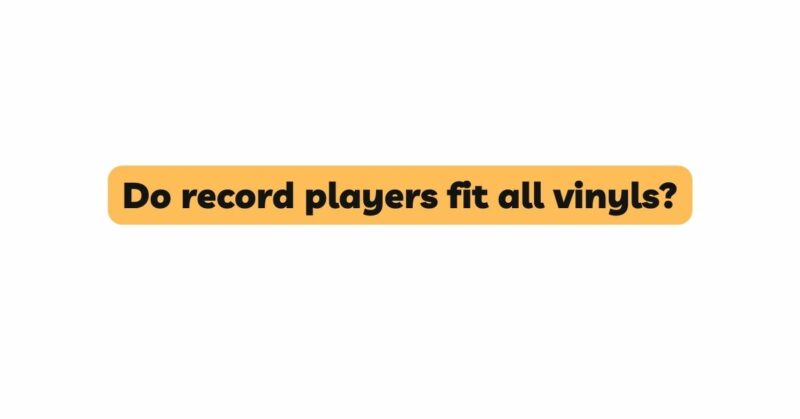The resurgence of vinyl records has sparked a rekindled appreciation for analog sound quality and tactile music experiences. As vinyls make a remarkable comeback, questions surrounding their compatibility with different record players have emerged. This article aims to unravel the intricate relationship between record players and vinyls, delving into the factors that influence whether record players fit all vinyls seamlessly.
The Vinyl Revival
In an era dominated by digital convenience, the revival of vinyl records has intrigued audiophiles and music enthusiasts alike. The allure of vinyl lies in its rich, warm sound and the tangible connection it establishes between the listener and the music. Handling a vinyl record, delicately placing the needle onto its grooves, and being rewarded with the unmistakable crackling and warmth of analog playback are experiences that transcend mere music consumption.
Understanding Vinyl Records
Before diving into the compatibility concerns, it’s crucial to comprehend the composition of a vinyl record. Vinyl records are made up of grooves, those mesmerizing spirals etched onto the surface. These grooves hold the audio information, and when a stylus glides through them, it translates the physical variations into sound waves that are then amplified and broadcast through speakers. The size, speed, and shape of these grooves, along with the vinyl material itself, contribute to the distinctive sound quality of each record.
The Mechanics of Record Players
Record players, often referred to as turntables, are intricate devices designed to reproduce sound from vinyl records accurately. A typical record player comprises several key components:
- Platter: The platter holds the vinyl record in place and provides a stable surface for playback.
- Tonearm: This arm extends over the record, holding the cartridge and stylus. It’s crucial for positioning the stylus correctly in the grooves.
- Cartridge: The cartridge is a small device that houses the stylus. It converts the physical grooves into electrical signals.
- Stylus: Also known as the needle, the stylus traces the grooves of the record, translating the physical variations into audio signals.
- Phono Preamp: The phono preamp amplifies and equalizes the weak electrical signal generated by the cartridge into a signal suitable for amplification by speakers.
Compatibility Factors
The compatibility between record players and vinyls isn’t a simple “one-size-fits-all” equation. Several factors come into play:
- Vinyl Size: Vinyl records come in various sizes, most commonly 7-inch, 10-inch, and 12-inch diameters. Each size requires a turntable with a corresponding platter size. Attempting to play a smaller record on a larger platter can lead to tracking issues and potential damage to both the record and the stylus.
- Playback Speed: Records are recorded at different speeds: 33⅓, 45, and 78 RPM (revolutions per minute). Turntables are equipped with speed settings to match these playback speeds. Playing a record at the incorrect speed alters both pitch and timing, affecting the intended sound of the music.
- Cartridge and Stylus Compatibility: Different cartridges and stylus profiles are designed for specific types of records. Moving Magnet (MM) and Moving Coil (MC) cartridges have unique characteristics that influence how they interact with different groove shapes and sizes. Using an incompatible cartridge or stylus can result in distorted audio and increased wear on the record.
- Tracking Force and Tonearm Weight: Vinyl records have a recommended tracking force, which is the pressure exerted by the stylus on the grooves. Turntables feature adjustable tonearms to achieve the optimal tracking force for a specific cartridge. Using incorrect tracking force can lead to poor audio quality, groove skipping, or excessive wear.
- Phono Preamp and Equalization: Vinyl records employ a specific equalization curve during recording to compensate for the limitations of the medium. Turntables include a phono preamp that applies the correct equalization curve for playback. Some modern turntables have a built-in phono preamp, while others require an external one. Mismatched equalization can result in altered sound quality.
- Record and Equipment Condition: The condition of both the vinyl record and the record player significantly influences compatibility. Dust, dirt, and scratches on the record can impact playback, while a poorly maintained turntable may not accurately reproduce the audio.
Conclusion
In the intriguing world of vinyl records and record players, compatibility isn’t a trivial matter. The resurgence of vinyl has rekindled a passion for analog sound quality, leading enthusiasts to explore the nuanced relationship between vinyls and record players. While the allure of vinyl lies in its timeless appeal and analog charm, achieving seamless compatibility requires an understanding of various factors such as vinyl size, playback speed, cartridge compatibility, and more.
As the vinyl revival continues to captivate audiophiles and newcomers alike, gaining insights into these compatibility considerations becomes essential for an optimal music experience. By comprehending the intricate mechanics of vinyl records and the technology behind record players, music enthusiasts can ensure that each note and rhythm is faithfully reproduced, capturing the essence of the artist’s intent and delivering a gratifying auditory journey.


